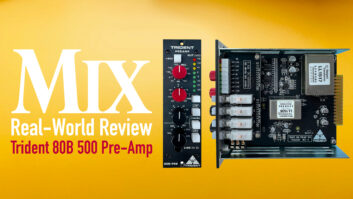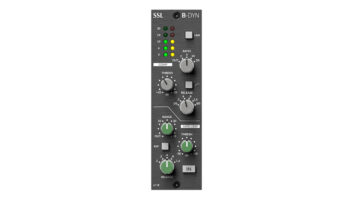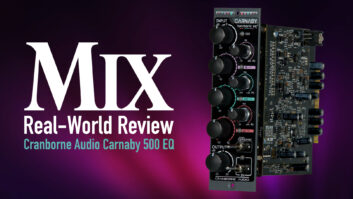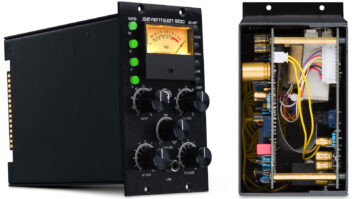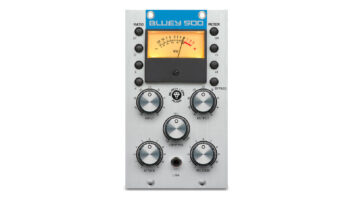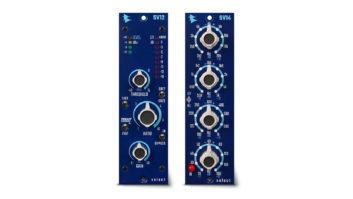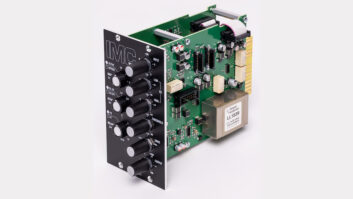
In 1976, aerospace engineers Mark Crabtree and Stuart Nevison founded Advanced Music Systems in Burnley, Lancashire, England. Their first product was the DM-20 Tape Phase Simulator, and it was an instant hit and used on many records at the time. In 1978 AMS introduced the DMX 15-80, a 15-bit, mono digital delay line, soon followed by the stereo DMX 15-80S.
Crabtree then invented the AMS RMX16 Digital Reverberator in 1981. It was the world’s first microprocessor-controlled and full-bandwidth reverberator.
In 1984, AMS produced the Audiofile, one of the first 16-bit hard disk recording systems, and it became immensely popular for film/TV post-production mixing. In 1988, AMS came out with the Logic 1 Digital Console—a fully configurable, automated desk that was superseded by the largeformat Logic 2 console. Siemens bought AMS in 1990 and merged it with Neve to form AMS-Neve in 1995. Mark Crabtree then bought the complete company back from Siemens in the mid-1990s.
AMS RMX 16
State of the art for the time, the original two-rackspace AMS RMX16 manipulated 16-bit audio samples with a large number of additions, divisions and subtraction during each sample period to produce high-quality reverberation. There are the equivalent of more than 1,000 delay line taps, each with its own amplitude weighting and timing required to simulate convincing and natural-sounding reverberation.
Rather than just strictly deploying mathematics, key to the RMX 16’s unique sound is that each of its nine original programs and their underlying algorithms were tuned and refined by ear to achieve the most natural-sounding reverberation possible. By simultaneously manipulating multiple reflection parameters using a particular ratio, a complex three-dimensional quality is created. This is the result of the ways the algorithms’ complex calculations react to those many different parameter changes.
The RMX 16’s nine reverb programs were stored on an EPROM chip (Erasable Programmable Read Only Memory) so that they could only be altered either by replacement or factory reprogramming. There was also additional RAM storage inside the unit, and that was re-programmable by using the rare, and little known, hand-held Remote Terminal.
The Remote Terminal plugged into the back of the RMX 16 using a RS-232 serial data cable. The Remote allowed control of RMX(s) located in an outboard equipment rack, and you could order a Hewlett Packard barcode reader wand for scanning reverb programs printed on sheets of paper. The Remote Terminal cost $1,180, the wand was $190, and program barcode sheets from AMS were free back in the ’80s.
AMS RMX16 500
The AMS RMX16 500 Series Digital Reverb module was launched at the 2020 Winter NAMM Show and is a much more compact unit that fits into just three slots of the popular API “Lunchbox” racks. Besides the original, and by now familiar nine programs, the new RMX comes with nine more carefully selected from the Remote Terminal’s collection, for 18 total.

The new RMX uses 24-bit, 48 kHz sample-rate audio and 32-bit DSP processing for over 100 dB of dynamic range and +22 dBu of headroom. The A/D and D/A converters and original hardware input/output performance specifications were modeled to sound the same as the original hardware. The DSP core was created from the original algorithms and are “line-for-line” the same coding that’s also used for the Universal Audio UAD-2 plug-in version.
Users of the original units will love that for the most part, AMS-Neve has kept the user interface/operation the same—tricky stuff considering the compact front panel on the RMX16 500 Series. The wide red LED display of the original RMX is replaced by a 2.4-inch OLED display mounted above the familiar 16-button alphanumeric keypad.
Upon powering up, the Program button lights up and its page comes up with the Ambience program running and its parameters available for adjustment. The RMX has three more pages, or screens, available: the Input and Output page with the new Wet/Dry Mix Control page; a new Save/Recall page with storage/recall for up to 100 user-modified Programs possible; and the Setup page, which has preferences like display brightness, screen saver mode, activation time and system reset.
The RMX16 operates simply. When pressing either the Program select or the individual parameter buttons of Decay, Pre, Lo, Hi, In, Mix, or Out buttons on the front panel, its red LED lights up. At that time, three different data entry methods become available for changing any of the 18 included reverb programs and/or their individual parameter values visible in the OLED display.
Borrowed from the original unit are the metal rotary encoder knob, the convenient down/up Nudge buttons, and the keypad for direct entry of parameter values only—you cannot change reverb Programs with the keypad.
Programs are held in non-volatile Flash memory without the need of an internal 3.6-volt battery, as with the original units. While there are no provisions to offload or copy programs from one unit to another, or to an attached computer, there is a front panel USB-C connector for installing firmware in the future. This unit came with the latest version.
INSTALLING AND USING THE RMX16 500
My memories of using the RMX 16 on sessions in the ’80s were instantly rekindled when installing and configuring the RMX16 500. I plugged it into the first three slots of my ten-slot Trident Deca Dent 500 Series Chassis. The 500 rack’s ±16-volt power is split between the two slots at 100mA each for a total of 200mA—well within the VPR limit of 140mA maximum per slot.
The first slot has the input and channel 1 output connections on its edge connector, and the third slot has the channel 2 output (only). The middle slot in the rack goes unused. Like the original, it requires only a mono signal input but has two outputs. I would send to it from one of my Pro Tools interface outputs and then return its two outputs back into two PT interface inputs routed to separate Aux Inputs, usually (depending on the selected program) panned left and right. You can mix the two outputs to mono, but you always check for phase issues.
With the new Wet/Dry feature, I wanted to try the RMX as an inserted processor. However, Inserts in Pro Tools use similar numbered inputs and outputs, so I could use an insert for input channel 1 because its output is also number 1. That meant I had to bring up the second output back on a separate Aux input fader. Wet/Dry mixing worked great, but only for input/output channel 1 as a mono reverb or delay.
MIXING WITH RMX16 500
The new RMX16 is incredibly quiet and noisefree when I use it in my Pro Tools mix sessions. Even with the Aux return faders at unity and then just “tickling” the unit’s input with an audio signal produces plenty of reverb level, with clear, noise-free detail in the decay. There is much more dynamic range as compared to the original 2U RMX16 as I remember. This is the ultimate RMX sound, where all the reverb programs are very “present” with a clear soundstage and not muddy, distant-sounding or unbalanced in any way.
I liked that the collection of adjustable parameters is minimal and simple as compared to the blizzard of parameters offered by modern digital reverb plug-ins and hardware. Since each program’s algorithms are “pre-tuned” for the most natural sound, in general you will not be able to crank them out of whack too much. I find this important; as a music mixer I want solid-sounding reverbs that work well fast!
The collection, availability and adjustability of parameters vary with each program depending on what the algorithm allows. The parameters are: Pre-Delay ranges up to 300ms, Decay Time up to 9.9 seconds for most of the programs, and then Decay Filtering, where both the high and low frequencies are separately controllable.
These decay filters are not EQs or filters; they are profiles applied to the final reverberant part of each program. The High Frequency Decay filter settings go from –9 to +0 and may affect the early reflections on certain programs. The Low Frequency Decay control affects the decay time of the reverberant field at 350 Hz and varies between –9 and +9. I adjusted these two parameters by what sounds good in my mixes.
[Note: The manual’s Appendixes A and B are worth a good study because they describe all 18 Programs completely. There are individual, major differences with each program, including the nature of the two output signals. Plus, there are recommended uses and notable features, and the history of the program is covered and what parameters are available for adjustment.]
AMBIENCE, YES!
I started with the classic Ambience program, and anyone who has ever used the original units has heard this general-purpose reverb—it is exactly the same here. It sounds somewhere between a long hall without early reflections and a plate reverb without metallic coloration.
I tried it on handclaps, drum fills, synth strings, vocals, choirs—everything—and I liked the way the reverberation builds up slowly, as if filling up a large open space. If you set it above 6.0 seconds Decay time, it starts to “freeze,” or continue ad infinitum with the reverb growing and changing with each additional audio input adding to an overall wash of continuous sound. You could record this continuous sound on two new tracks and have a constant “pad-like” sound and play throughout the entire song.
ROOMS AND MORE ROOMS
I had well-played, double-tracked acoustic rhythm guitars and wanted a short room ambience around them. I chose Program 12 Room A0 set to 2.0 seconds and increased the high-frequency decay profile. It put a very short “halo” around those guitars without blurring the attacks at all.
If I wanted the same guitars to occupy a bigger room, I went with Program 13 Room B1—it has constant diffusion density and is a different algorithm. Putting the highfrequency control to +0 makes it sound like the synthesized room has less damping, harder room surfaces and overall brighter acoustics.
PROGRAM 16 DELAY
The RMX has a digital delay line within Program 16 Delay. The delayed audio comes out of Output 2 only. Output 1 is just the AD/DA round trip, and I would pan this output to the left, with a hand percussion track driving it panned right. Those two audio signals make a tight, stereo doubling effect from just a single track, but check this effect listening in mono, as there may be some phase cancellation (there was no problem in my example here).
The Pre-Delay parameter sets the delay time in 10ms increments up to 810 ms on Output 2. For this effect, I panned Out 2 to the center with a setting of 610 ms for a quarter-note delay at the song’s tempo. The Decay time parameter controls the number of non-deteriorating repeats (slapback echoes that do not dull or distort with each repeat). I set it to 4 for four repeats.
THE EXALTED NONLIN2, NONLIN1 AND FREEZE
As with Ambience, the NonLin and Freeze programs were sounds that were heard on so many big hit records from the ’80s.
Program 8 Nonlin2 is a short reverb that decays nearly instantly. I always like it as a mixing element—a “spice” for snare drums or handclaps. Used sparingly, it makes handclaps apparently louder (without a big level change) and sounding like more sets of hands clapping when the RMX’s returns are wide-panned left and right. The two outputs provide diffuse reflective reverb and is key to this program’s popularity.
Program 16 NonLin1 is more “alien sounding” and similar to NonLin2, except that the two outputs have two different sounds—Out 1 has discrete, “fluttery” reflections, while Out 2 is more diffuse and reverb-like. I would mix the two outputs into the center under the snare drum track.
Program 11 Freeze refines and controls the way sounds could be added to the Ambience program for infinite reverberation. There are only two active controls: Pre-Delay and Decay time.

I used the Nudge button to toggle Decay time from 0.1, or no input signal allowed, to 0.2 when any audio input will be added into the continuous sustaining reverb. In this way I could build whole chords in a sustaining reverb by selectively adding individual notes from an already recorded singer. Once built up, I would record it back onto a new stereo audio track.
SAVE AND RECALL
I named, saved and recalled many tweaked programs. As a standard operating procedure for send/return effects, I would first check the I/O settings and make Input, Output and the Wet/Dry Mix all 100 percent.
The 18 Programs are named and numbered in the manual, but not always numbered on the unit’s OLED display itself. It works perfectly, although when you save a preset derived from one of the 18 Programs, your new name is not shown on the Program screen after you recall it. The display just shows the particular “anchor” program you started with and used.
I’d like to see all program numbers in the manual correspond and displayed next to each program name in the OLED display. The newly named edited programs’ names should show up in the OLED, with the anchor program’s number included.
HARDWARE REVERBS RULE!
Having a solid-sounding digital reverb in a 500 rack is an awesome addition to any studio control room. No matter how DSP-complex, or if you’re running higher sample rates and large track counts in Pro Tools sessions, the RMX just works and always sounds the same—great! The RMX16 500 is just awesome and highly recommended!
PRODUCT SUMMARY
COMPANY: AMS-Neve
WEB: www.ams-neve.com/ams-rmx16-110-p.asp
PRODUCT: AMS RMX16 500 Digital Reverb
PRICE: $1,295
PROS: Same exact algorithms as the original, but quieter and cleaner
CONS: Saving and recalling modified programs could be Better

